YOU ARE HERE >> AmazingRibs » Ratings & Reviews » BBQ & Grilling Technique And Science » Pizza Perfection: Everything You Need To Know » Ooni Volt 12 Electric Pizza Oven Review And Rating
Ooni Volt 12 Electric Pizza Oven Review And Rating
All of our reviews are done independently by our team of testers and are in no way influenced by advertising or other monetary compensation from manufacturers. Click here to learn more about our unbiased product review process.
Published On: 4/17/2024 Last Modified: 11/4/2025
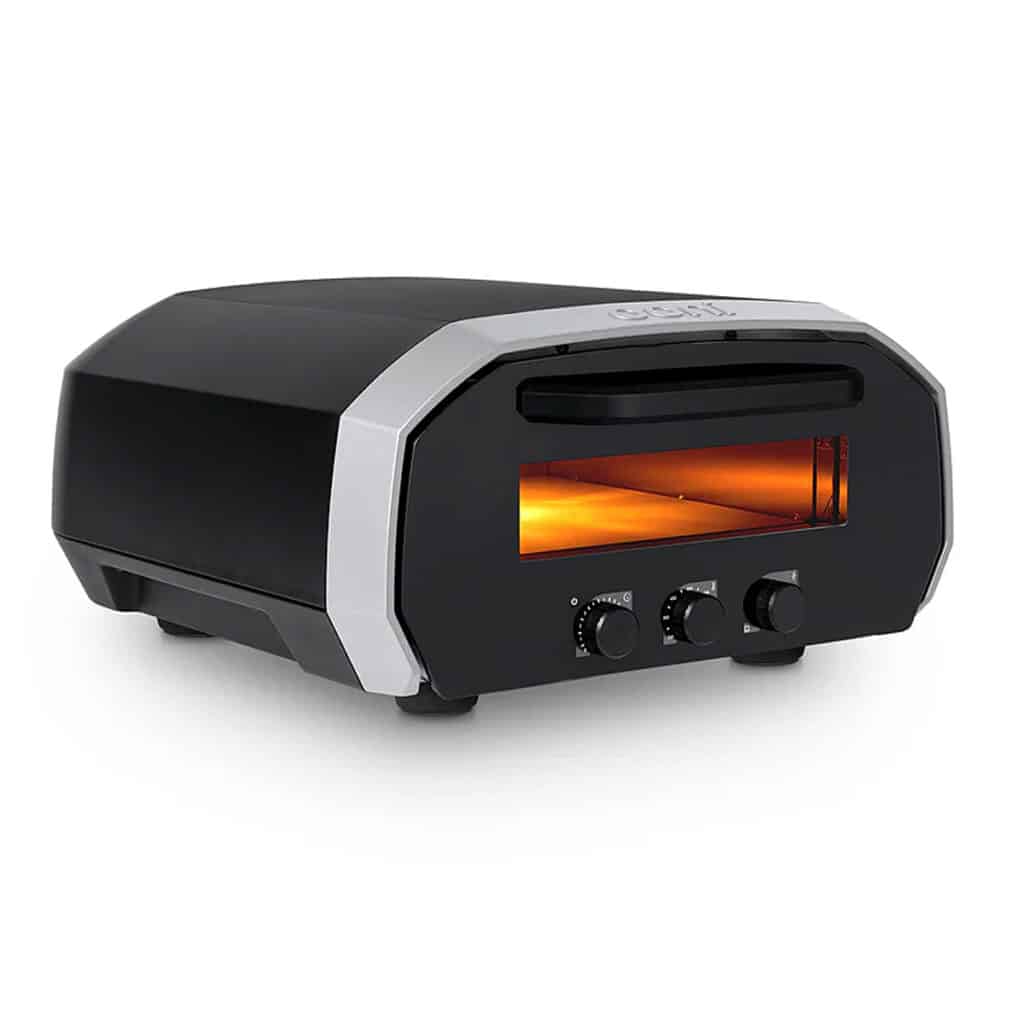
Here’s a comprehensive hands-on look at a compact, energy-efficient electric oven that achieves temps exceeding 850ºF.
Way back in 2012, the husband and wife team of Kristian Tapaninaho and Darina Garland, launched a Kickstarter campaign to market the Uuni, a portable, wood-fired, backyard pizza oven. (Kristian is Finnish and “uuni” means oven in Finnish.) Many years and a name change later, Ooni has completely revolutionized the pizza oven market. Now, they have a whole range of wood, charcoal, gas, and multi-fuel pizza ovens of varying sizes (and lots of competition.) Ooni’s latest model? An energy-efficient electric pizza oven that’s as happy on your indoor countertop as it is in your backyard pizza kitchen.

Construction
True to the company’s roots, Ooni’s newest electric oven prioritizes portability. The Ooni Volt 12 Electric Pizza Oven is about the size of a large toaster oven, weighs less than 40 pounds, and has dugout handles on the sides so you can take it to a pizza party, a beach house, or camping (with electric hookup, obviously). The body is constructed of stainless steel (inside) and carbon steel (outside). The black powder-coated shell helps protect the oven from the elements, but a cover makes a wise investment if you’re storing Volt 12 outside and exposed (Ooni sells a form-fitting one). I kept my test unit in the garage, uncovered, for months through the rainy fall, snowy winter, and rainy spring with no issues whatsoever.
Like what you’re reading? Click here to get Smoke Signals, our free monthly email that tells you about new articles, recipes, product reviews, science, myth-busting, and more. Be Amazing!
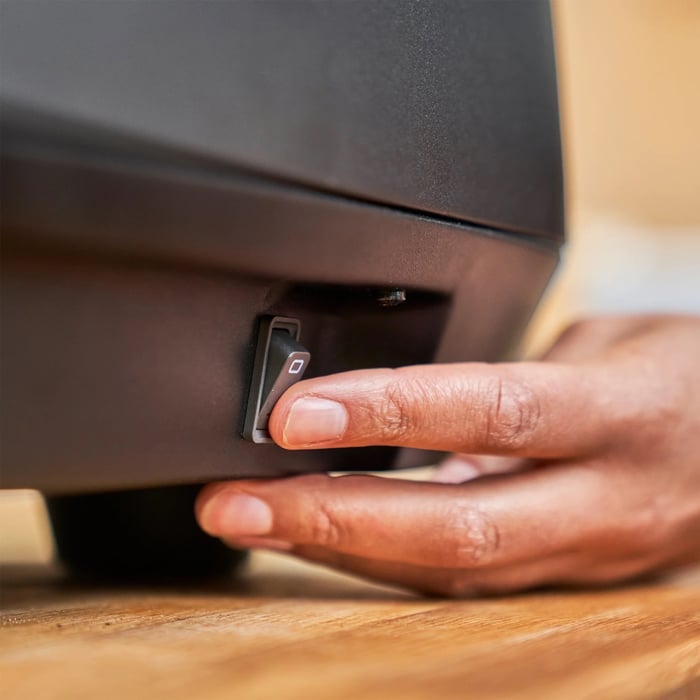
Features
Ooni Volt 12 Electric Pizza Oven is designed to be plug-and-play. Unbox it, plug it into a standard 120-volt receptacle, and it gives you 1600 watts to play with, about the same as a microwave oven. That powers two round electric heating elements visible on the inside top and bottom of the oven that get the temperature to an advertised 850ºF (see Cook Tests below for details). On the front door, Volt 12 has four manual controls, plus a standby power switch hidden on the exterior right side. That’s handy so you can kill power to the front-door controls without unplugging the entire unit in case, say, some kids are lingering near the oven and you don’t want them to accidentally turn it on. You can also leave the standby power switch on, and Volt 12 is always ready to rock.
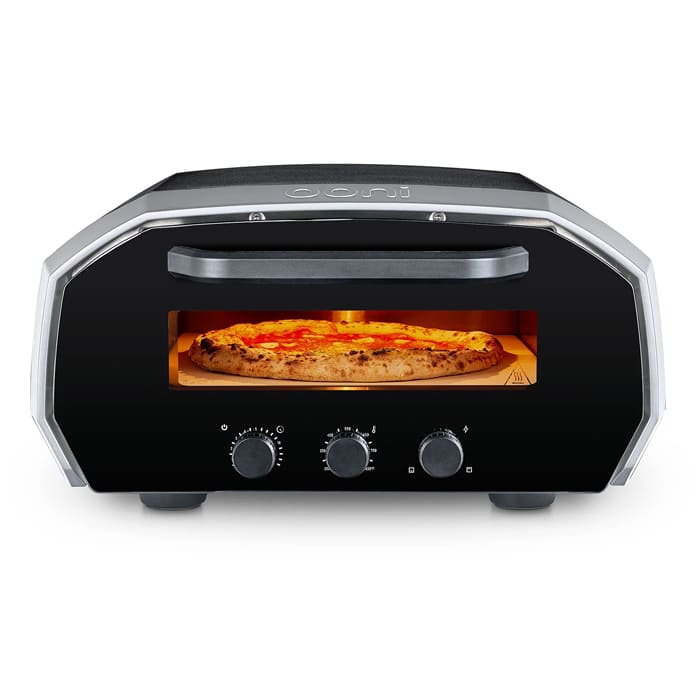
Up your game: Join our Pitmaster Club. Try it out for free for 30 days. No credit card is needed. No spam. Join now and Be Amazing!
Functionality
The triple-pane borosilicate glass door lets you see the food while holding in heat. (Keep that glass clean.) Controls mounted on the glass door include a touch-sensitive on/off button on the left and three knobs: timer knob (0 to 20 minutes), temp knob (250 to 850ºF), and heat balance knob for the top and bottom heating elements. When you power on Volt 12 and turn the temp knob, the set temp flashes until it is reached, and then it’s lit solid.
Depending on your set temp, the heat balance presets for typical pizza cooking temperatures. For example, if you crank the temp all the way up to 850ºF, Volt 12 assumes you’re cooking something like a Neapolitan-style pizza, which requires max top heat to create a big, puffy, charred rim. If you set the temp all the way down to 250ºF, the oven presets for even top and bottom heat. Starting at 400ºF, Volt 12 begins auto-adjusting the heat balance for increasing top heat and lands on max top heat at 800ºF and 850ºF.
Boost Mode Feature
Once the oven reaches its set temp, the dial displays the heat balance. At that point, you can adjust the heat balance however you like by turning the knob (set temp remains the same). That’s super-handy if you’re in the middle of cooking a pizza at, say, 650ºF, but you decide it needs more top heat after launching it: just turn the balance knob to max top heat. It can also help with the pizza stone’s heat recovery time. Ooni calls this “Boost Mode.”
Essentially, you turn the heat balance knob all the way to the left for max bottom heat, which gets your stone back up to crust-crisping temps in just a few minutes. Then when you launch a pie, you can re-adjust the heat balance to best cook the kind of pizza you’re making. I love the heat balance knob. Heat recovery is important for speeding up production. And controlling the top/bottom heat balance on the fly can be critical for achieving “simultaneous pizzagasm” as Meathead calls it, where the crust and toppings (such as raw meat) are perfectly cooked at the same time.
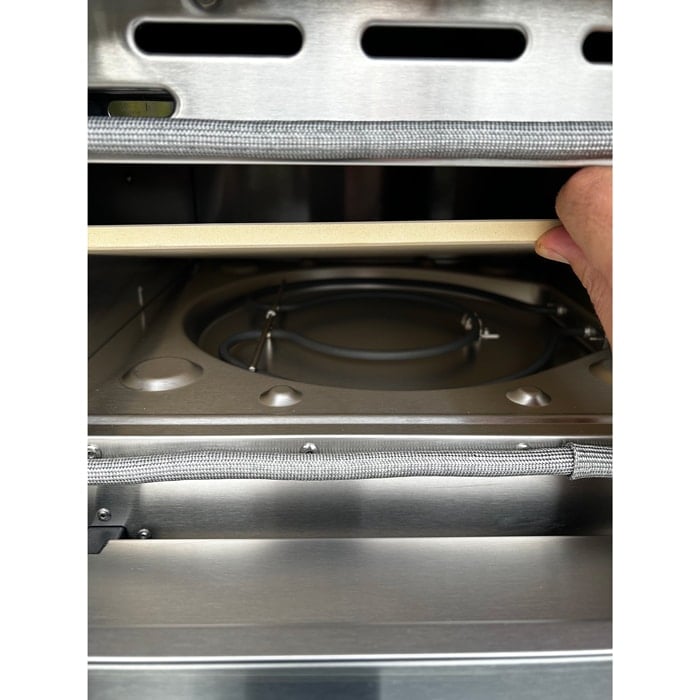
Want a new set of tools? Check out Meathead’s new book, The Meathead Method. It’s a toolbox that will elevate all your cooking. Alton Brown calls it “The only book on outdoor cookery you’ll ever need.”
What’s Inside
Inside, Volt 12 has a 13-inch square, 0.4-inch (10mm) cordierite baking stone that easily handles up to a 12-inch round pizza (hence the name Volt “12”). The stone is removable so you can brush it clean and replaceable if it breaks. All baking stones can crack, typically from thermal shock, that sudden extreme temperature change from cold to hot or hot to cold. They can also crack from excessive moisture. Always make sure a pizza stone is completely dry before heating it. If your pizza stone does crack, no biggie: you can still cook on a hairline-cracked stone. Or if it completely breaks in pieces, you can easily slip a replacement stone into Volt 12. Ooni sells them for 30 bucks.
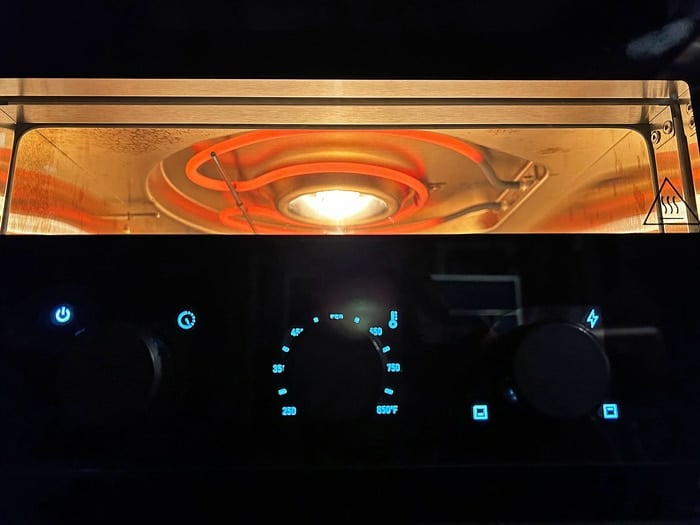
Dinner Music
Volt is a musical pizza oven, playing dulcet startup tones then chirps with rising tones for each temperature notch as you turn up the temp knob. I’m not sure why Ooni decided this audio was important to accompany the visuals on the knobs. Another useful feature is the interior dome light. It’s super bright and illuminates your food along with the entire oven. It’s fun to watch pizzas bubble up from raw to cooked, and the dome light makes your pizza instantly Instagrammable.
One last feature: if you leave the oven on and haven’t used it for 45 minutes, it shuts off automatically. Auto-shutoff is a plus for those of us who tend to get carried away eating pizza, drinking beer, and shooting the s**t. Thank you Ooni.
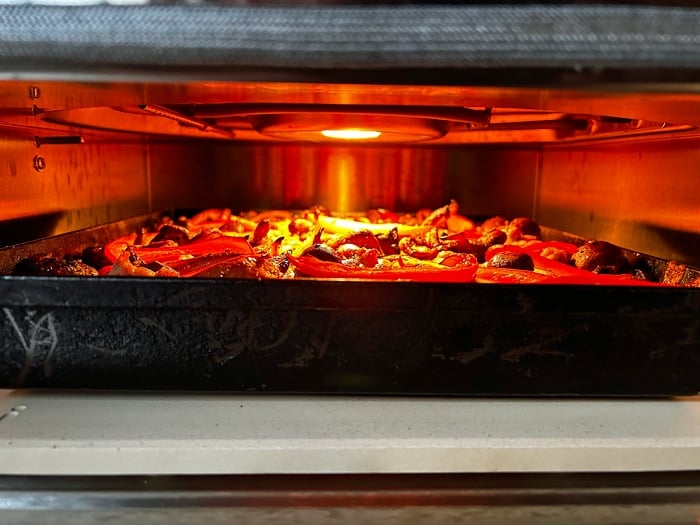
Volt 12 Cook Tests
At test time, I was trying out some recipes for a Detroit-style pizza cookbook from Down North Pizza, a fantastic Philadelphia pizza shop. For the first cook, I set Volt 12 to 700ºF, the temp called for in the recipes. Then I started my stopwatch. It was a cool October evening, and after 10 minutes of preheating, the temp knob showed the oven had reached 500ºF. I checked the stone temperature in dead center, and my infrared gun read 550ºF. That’s pretty quick heating, a testament to this oven’s compact efficiency.
After 15 minutes of preheating, the oven made a short beeping sound and the display lit up solidly, indicating it had reached the 700ºF set temp. I checked the stone again, and it read 650ºF. I let Volt 12 preheat for another 10 minutes (25 minutes total), and the stone temp got up to 685ºF. Ready to rock. The heat balance had been preset for mostly top heat, so I reset it for more even top and bottom heat to make sure I got a nice crunchy bottom crust on this Detroit-style pan pizza.
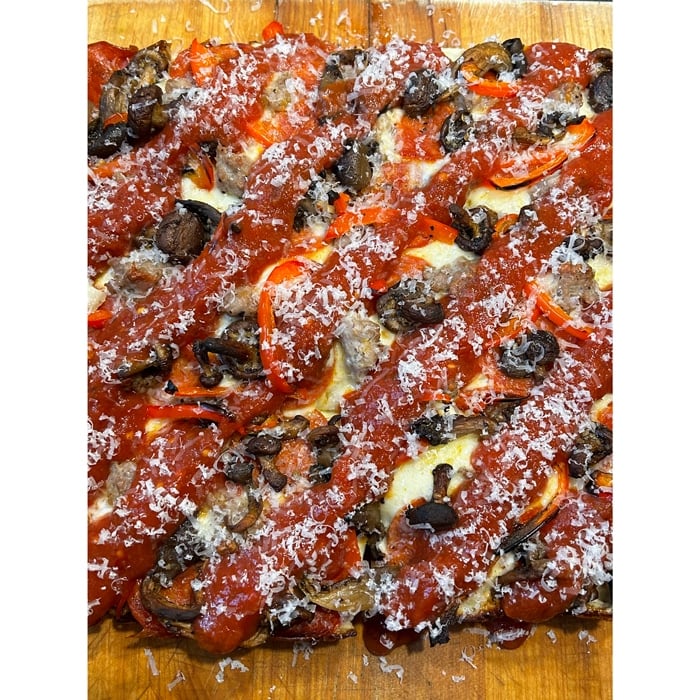
Cooking Process
In went a four-cheese meat lover’s pizza with sausage, pepperoni, sauteed mushrooms, red bell peppers, and spicy-sweet tomato sauce. It came out great—crunchy outside, fluffy inside, and drenched in meaty, cheesy flavor. But I should’ve left the heat balance knob alone. I had to switch it back halfway through cooking to get more top heat to finish cooking the meat. Lesson learned: Trust the preset.
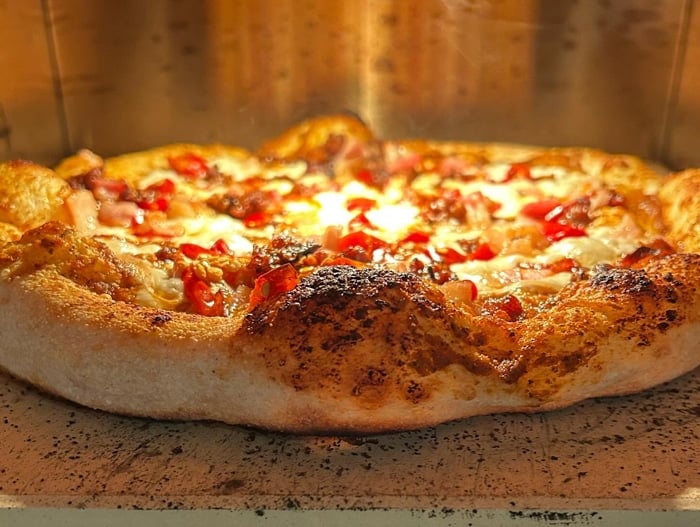
On the next test, it was 42ºF outside, and I was craving Neapolitan-style pizza. I preheated Volt 12 to max heat, 850ºF. With the chilly ambient temp, it took 30 minutes to get there. The stone registered 789ºF dead center. That’s plenty hot, so I launched a classic sausage roasted pepper pizza, and it was ready 2 minutes later. Crisp, puffy rim. Soft, fluffy dough. I made a few other Neapolitan pies that night, including an improvised blue potato and blue cheese combo with caramelized onions and white sauce. Hot damn. That was tasty. It’s since become a regular on pizza night.
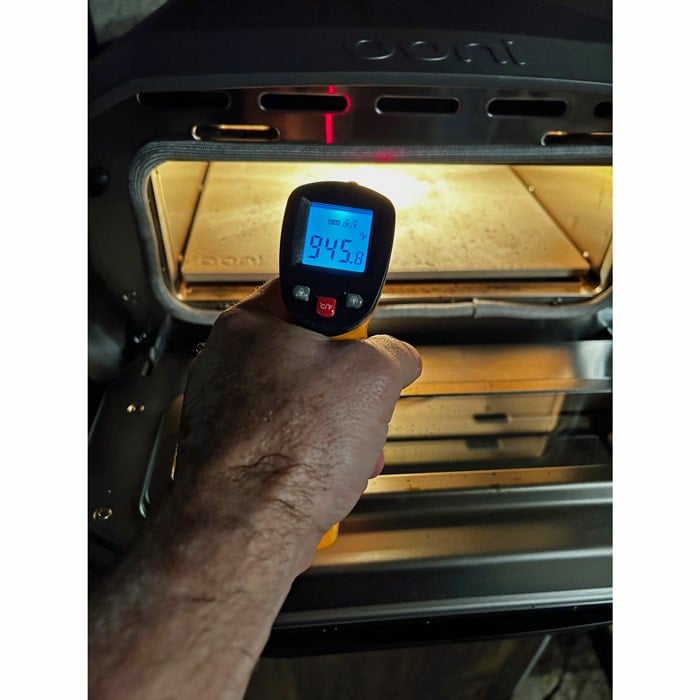
First Test Results
These pies all had a crispy, lightly charred bottom crust thanks to Volt 12’s Boost Mode (turning the heat balance to “all bottom” between pies). After a few pizzas, I settled into a rhythm of leaving the heat balance top-heavy to cook the topping, and turning it to Boost Mode between pies to reheat the stone. Worked like a charm. However, on one occassion I lingered inside for a little over 10 minutes with Boost Mode on and when I came back, my Infrared Gun showed the stone temp had reached 945ºF. Holy Hannah, that’s hot! I switched the heat balance back to top-heavy, and doncha know, that was the best pie of the lot. Of course, we ate it so fast, I didn’t get a picture. The lesson: use Boost Mode between pies, and the longer you let it go, the crisper your bottom crust will be.
Square-Pie Test
Back to the square-pie tests. Chicken and seafood were on the menu this evening, and measuring the baking stone’s recovery time was on my test checklist. It was a 50ºF night and I set Volt 12 for 700ºF. I went inside to prep, got distracted, and came back about an hour and ten minutes later.
With the first pie in hand, ready to go, I saw that the oven was no longer on. I forgot about auto-shutoff. I checked the stone and it still registered 600ºF, so I turned Volt 12 back on to 700ºF. Just five minutes later, the oven beeped: it had reached the 700ºF set temp. I checked the stone, and it registered 675ºF. Quick recovery! This mistake shows just how well insulated Volt 12 is. I had shut the oven off 25 minutes earlier and it still came back up to a 700ºF temp in just 5 minutes.
All of these Detroit-style pizzas get cooked in 10-inch square, 2-inch deep blue steel pans. With the oven’s Boost Mode, the heat conductivity of these pans (and some olive oil) makes the bottom crust super crunchy. One of the best pies of the lot was from Reem Assil, a Palestinian chef with a restaurant in California. Reem’s “Pali Cali” pizza with sumac-braised chicken thighs, caramelized onion puree, pomegranate molasses, pickled red onions, and fresh arugula was an absolute knockout (look at those colors!).
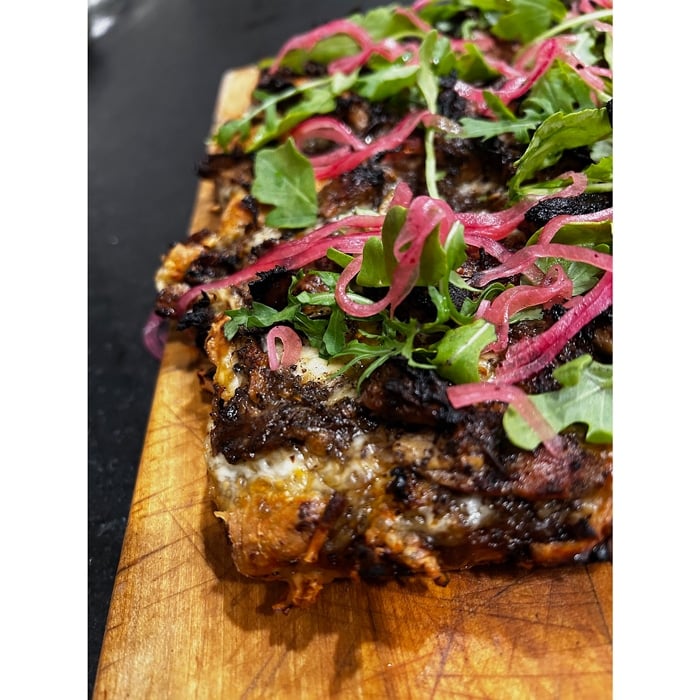
That night, I also made a seafood pie with lump crabmeat on garlic-parmesan white sauce blanketed with melty mozzarella, provolone, and white cheddar, and topped with fried butterflied shrimp, fried kale chips, and a drizzle of creamy tomato sauce. Buuuurp. That one was mighty good.
Vegan Pie Test
I tested a vegan pie, too, with Jamaican-style “beef” patty topping (soy protein), Scotch bonnet chiles, and a drizzle of spicy West Indian mayo on top. For this and the seafood pie, I had to play with the heat balance during cooking to make sure the toppings got nicely browned but not so much that they burned. These square pies were great examples of just how important the heat balance knob is for properly cooking different styles of pizza in Volt 12.
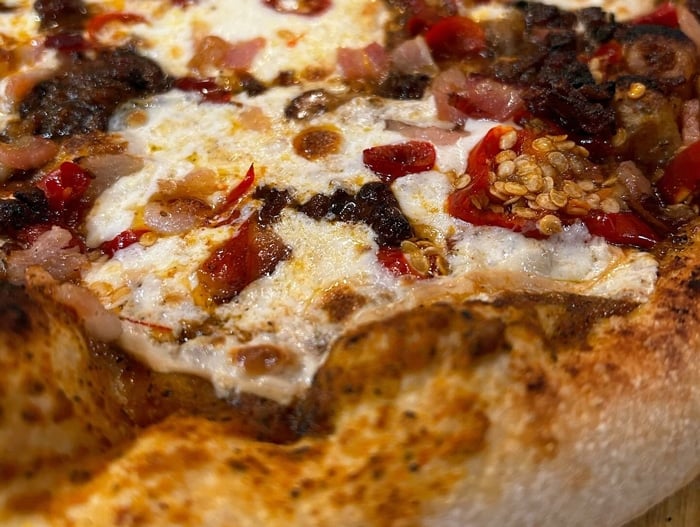
Neapolitan Pie Test
My pizza tests concluded with more Neapolitan pies, including this bacon, sausage, fontina, and Calabrian chile combo. Sometimes throwing open the fridge and throwing whatever you find onto a pizza works magic.
A note on this pizza: during cooking, it had a rogue bubble on the rim that started over-charring before the pie was done. I managed to save it from getting incinerated thanks to Volt 12’s heating element placement. If you look inside the oven, you’ll see that the top heating element enters from the right side. At the entry point near the oven wall, it doesn’t glow red-hot but looks dark gray instead and stays cooler (just like in a toaster oven). I rotated the pizza so the rogue bubble was positioned directly below the cool spot. It worked, and saved the pizza from getting over-charred.
Side note: Ooni Volt 12 Electric Pizza Oven is slightly cooler near the front door, especially in colder weather. The oven cooks pretty evenly overall, but it’s a good idea to rotate your pizza for even cooking.
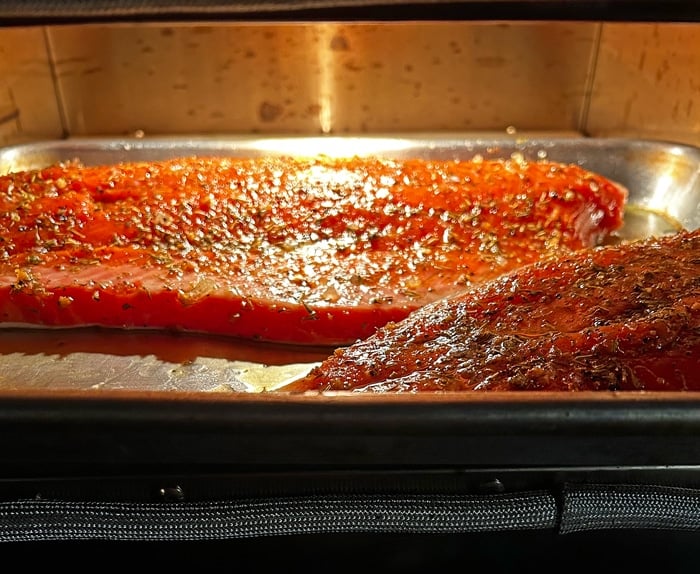
Misc. Testing
Of course, I had to test a few other things in this compact heat machine. I roasted some meat, fish, and veg at slightly lower temps. These salmon fillets were rubbed with Meathead’s Amazing Tuscan Herb Seasoning & Dry Brine (co-developed by yours truly), plus a little algae oil. Never heard of algae oil? At 535ºF, it’s the highest smoke-point oil available. That can be a plus when you’re grilling or roasting at high temps so you don’t get lots of noxious smoke. I set Volt 12 to 500ºF and then slid the sheet tray of fish inside. No turning necessary: the hot baking stone, pan, and oil crisped up the bottom skin in just a few minutes.
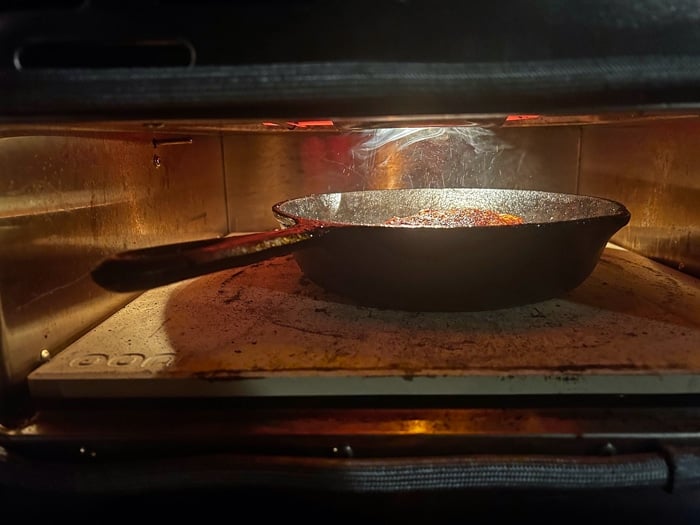
A burger test was last because I knew there’d be some grease stains, and I’d have to clean the oven interior. As expected, the ground chuck spit a fair amount of fat and juices during the cook. But it was fun to watch that happen (kudos again to the dome light). I built up this juicy burger on a butter-toasted brioche bun with crispy bacon, sharp cheddar, sriracha mayo, ketchup, lettuce, and pickle relish. My son had to unhinge his jaw to bite into it. Within 5 minutes, it was gone.
Conclusion
All in all, Volt 12 is a great little pizza oven or second oven to have on hand. You can keep it on the kitchen countertop to roast vegetables, fish, and meats without having to heat up your big oven. And, of course, top-quality pizza is always just 20 minutes away. Or, if you prefer to cook outside, you can store Volt 12 there instead. With built-in carry handles and a manageable weight of 40 pounds, you can also bring Volt 12 on a road trip, to a friend’s house, or anywhere with a standard 120-volt outlet.
A couple nits to pick: The 20-minute timer seems superfluous. Most pizzas cook in just a few minutes, and you need to watch them anyway. Plus, cell phones have timers these days, which is better for longer cooks because you’re probably walking away from the oven. I never used Volt 12’s timer, and I doubt I ever would.
At $999, this oven is not cheap. In fact, it’s Ooni’s most expensive oven to date. The company did recently drop the standard price to $899. Still, that’s some serious scratch. Is it worth it? If you love pizza, want 850ºF cooking temperatures, and don’t have the space for a giant pizza oven, Volt 12 could be the hot box for you. Does the pizza quality match that of a wood-fired or gas oven? In my experience, it’s pretty darn close. The main thing you want in a pizza oven is high heat, and Volt 12 achieves it with ease and speed.
Comparison
Does it beat the competition? Ooni Volt 12 Electric Pizza Oven is similar in size, weight, price, and functionality to its closest competitor, the Breville Pizzaiolo (read our review of the Breville here.) Back in 2019, Breville was the first to market a high-temp electric pizza oven designed for home countertop use. Ooni’s competing model has a slight advantage in that it achieves slightly higher temps (although I have gotten the Breville above 800ºF). The Ooni can also stay outside, whereas the Breville is meant for indoor use. On the downside, the Ooni has a slightly larger footprint (it’s almost six inches deeper) and is nearly 2 pounds heavier. The Ooni also doesn’t come with any accessories (the Breville comes with a stainless steel pizza peel and a 12-inch round carbon steel pizza pan, a $110 value).
These are minor quibbles. The bottom line: Ooni’s Volt 12 is a well-designed, compact, energy-efficient electric oven that achieves raging hot temps capable of cooking fantastic pizza, steaks, fish, vegetables, and more. After months of cook tests and tinkering, it earns a well-deserved Platinum medal.
Warranty
All Ooni products come with a manufacturer’s warranty for 1 year as standard. Ooni will extend the warranty to 2 years when you register the product within 60 days of purchase
We thank Ooni for providing a Volt 12 Electric Pizza Oven for our tests.
Click the buttons below to search our complete database of reviews:
Product Information:
-
Model:Volt 12 Electric Pizza Oven
-
Item Price :899.00
*Price Subject To Change -
Where to buy: ** buying from one of these suppliers will help support this website.
-
Review Method:Cooked On It
We have hands-on experience testing this product. We have also gathered info from the manufacturer, owners and other reliable sources. -
Primary Function:Grill, Pizza Oven
-
Fuel:Electric
Manufacturer:
-
Ooni (formerly Uuni)

Ooni is a European company started in 2012 under the name Uuni with the premise of, “making the world’s first portable wood-fired pizza oven.” They kicked it off with 142 Kickstarter supporters and have since grown to a global enterprise. Ooni currently offers two models and some pizza making accessories. In 2018 they changed the name from Uuni to Ooni, feeling the new spelling is easier to remember and pronounce correctly.
Related reviews
- Breville Pizzaiolo Smart Pizza Oven, Review And Rating
- Roccbox by Gozney Pizza Oven Review And Rating
- Culinary Chef Pizza Maker Review And Rating
-
Dave Joachim, AmazingRibs.com Editorial Director - Editorial Director of AmazingRibs.com, David Joachim has authored, edited, or collaborated on more than 50 cookbooks, four of them on barbecue and grilling, and his Food Science column appeared in "Fine Cooking" magazine from 2011 to 2019. He’s a perfect match for a website dedicated to the “Science of Barbecue and Grilling.”

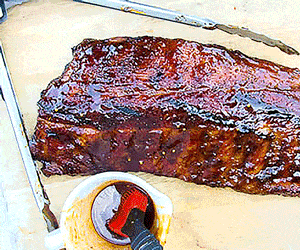
High quality websites are expensive to run. If you help us, we’ll pay you back bigtime with an ad-free experience and a lot of freebies!
Millions come to AmazingRibs.com every month for high quality tested recipes, tips on technique, science, mythbusting, product reviews, and inspiration. But it is expensive to run a website with more than 2,000 pages and we don’t have a big corporate partner to subsidize us.
Our most important source of sustenance is people who join our Pitmaster Club. But please don’t think of it as a donation. Members get MANY great benefits. We block all third-party ads, we give members free ebooks, magazines, interviews, webinars, more recipes, a monthly sweepstakes with prizes worth up to $2,000, discounts on products, and best of all a community of like-minded cooks free of flame wars. Click below to see all the benefits, take a free 30 day trial, and help keep this site alive.
Post comments and questions below
1) Please try the search box at the top of every page before you ask for help.
2) Try to post your question to the appropriate page.
3) Tell us everything we need to know to help such as the type of cooker and thermometer. Dial thermometers are often off by as much as 50°F so if you are not using a good digital thermometer we probably can’t help you with time and temp questions. Please read this article about thermometers.
4) If you are a member of the Pitmaster Club, your comments login is probably different.
5) Posts with links in them may not appear immediately.
Moderators